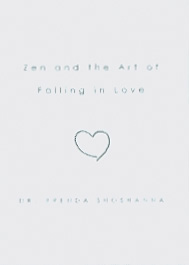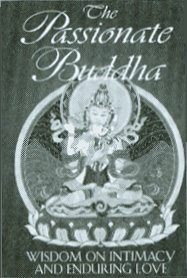
Love Dharma: Relationship Wisdom From Enlightened Buddhist Women
Geri Larkin
Boston: Journey Editions, 2003
240 pp.; $12.95 (paper)

Zen and the Art of Falling in Love
Brenda Shoshana, Ph.D.
New York: Simon & Schuster, 2003
272 pp.; $21.00 (cloth)

The Passionate Budha: Wisdom On Intimacy and Enduring Love
Robert Sachs
Rochester, VT: Inner Traditions, 2002
242 pp.; $14.95 (paper)
An issue for many dharma students today is how to bring practice awareness to intimate relationships or, at the very least, how to be more conscious in love. Three new books—Love Dharma, Zen and the Art of Falling in Love, and The Passionate Buddha—offer assistance, on the premise that Buddhism has plenty of insight on matters of the heart. The authors are longtime practitioners—one is an ordained dharma teacher—and they venture beyond the self-help formula to emphasize traditional teachings as much as practical advice.
Geri Larkin’s Love Dharma—the quirkiest of the three books—is as subversive a relationship guide as you’re likely to see. The subtitle promises “relationship wisdom from enlightened Buddhist women.” But for all the “wisdom”—and there’s a ton, much of it born of the author’s checkered past—this is at heart a paean to the Buddha’s first female followers, whose struggles—including love troubles—drove them to take refuge.
A Zen teacher in the lineage of Korean master Samu Sunim, and founder of the Still Point Buddhist Temple in Detroit, Larkin mined early Theravadan texts for material on these spunky women. (Much of it is from The First Buddhist Women, Susan Murcott’s translations and commentary on the Therigatha, and Portraits of Buddhist Women, a translation of theSaddharmaratnavaliya, a thirteenth-century Sinhalan work.) Retelling their tales of love, loss, jealousy, and transformation, Larkin finds a lesson on impermanence in every indignity the women suffered, from fading beauty to infidelity. We meet the courtesan Ambapali, once a powerhouse, whose poetry is a wry comment on the withering effects of age: “My hair was black, the color of bees,/ Each hair ending in a curl.
Now on account of old age/ It has become like fibers of hemp”; Isadasi, the “perfect” wife who suffers abandonment; Patacara, destroyed by lust; Sirima and Uttara, archrivals who learn the value of female friends. The relationship do’s and don’ts Larkin extrapolates from the stories are almost beside the point. More significantly, these pioneering women “stand as models for how we can transform our personal tragedies into our own awakening. . . . In the wake of their experiences arose relationship dharma.”
“Relationship dharma” is Larkin’s sometimes antic spin on essential Buddhist teachings, recast to help women cope with issues like adultery, “relationship rage,” and competition. She prescribes the Noble Eightfold Path as a cure for jealousy, and meditation to get over an ill-advised affair. The paramitas (perfections) are reconstituted as “rules” for ensuring partnership equality.
Author of several spiritual memoirs—the latest is First You Shave Your Head—Larkin has a wisecracking, confessional, girlfriend-to-girlfriend style that at times obscures her message: how vibrant these early dharma women were, and how many obstacles they overcame in pursuing enlightenment.
“The wonderful, ancient practice of Zen is actually the practice of falling in love,” psychotherapist Brenda Shoshanna, Ph.D., tells us in Zen and the Art of Falling in Love. The relationship expert on iVillage.com and a Zen practitioner for more than thirty years, she declares at the outset: “We are meant to live a life of love. When we’re not in love, something’s the matter.”
This is relationship, samurai-style, as we are systematically led along the path from “becoming available” to “meeting the beloved.” At each stage of Zen training, we receive an analogous lesson on love. Thus, step one of Zen practice—removing our shoes to enter the zendo (meditation hall)—is about dropping our defenses and opening to both the dharma and the possibility of love. “Sitting on the cushion” is a lesson in “meeting yourself”; “doing nothing,” on “releasing control”; cooking, on “nourishing others and oneself.”
Chapters on sesshin (intensive Zen retreat) and koans (Zen paradoxes) focus on strengthening the ability to work through obstacles until we taste the fruit of relationship practice—union with the “perfect” partner (perfect because now we can see perfection in everyone). “As this happens . . . you do not have to search for love, you are living it, day by day.”
Shoshanna studied with the Japanese Zen masters Soen Nakagawa Roshi and Eido Shimano Roshi; the rigor of traditional monastic training shines through the spare language and format. Aspects of Zen practice that can be controversial or confounding are presented matter-of-factly. A few of the love lessons may even raise eyebrows. Consider this explanation of the keysaku, the wooden “encouragement” stick used to strike students during zazen (sitting meditation) to keep them alert: “Most important, it teaches the students how to receive sudden blows and pain. This is necessary, as a fundamental part of learning the art of falling in love is knowing how to receive the stick.”
Similarly, we are told that dokusan, the one-on-one student-teacher meeting central to Zen training, prepares us for “moments of dramatic choice” in a relationship. “When we have this intense, immediate, no-holds-barred encounter with the master, we are learning . . . what is essential in order to really be with another and available for love.” This description may seem ironic to readers familiar with the improprieties committed by a number of spiritual teachers in recent years.
Zen love, like Zen practice, is not for the timid. If the path at times seems too steep, the reader can just follow the “Stepping Stones to Love” in each chapter—small actions that, like consistent meditation practice, lead incrementally to awareness. “Each instruction in Zen training is a metaphor for our entire lives, an instruction to diligently follow and practice day by day,” Shoshanna reminds us. For those with love issues—isn’t that most of us, at one time or another?—she holds out the redemptive possibilities of practice: “By simply paying attention to each step we take, by becoming that attentive and present, we can turn around our relationships.”
If Zen is the direct path to relationship nirvana, Tibetan Buddhism is the ecstatic route. InThe Passionate Buddha, Robert Sachs draws on twenty-seven years of marriage and Tibetan Buddhist practice (his teachers include Chogyam Trungpa Rinpoche, Lama Ole Nydahl, and Kungiz Shamar Rinpoche) to map the way to bodhicitta, the awakened heart. Like Shoshanna, Sachs is unequivocal about the spiritual significance of intimate relationships: “True love . . . [is] the only path to liberation and fulfillment . . . Knowing how to truly love in every moment and every situation is the quintessential perfection of being human.”
Sachs addresses the question “What does a conscious, loving, and enduring relationship look like?” with practices to foster flexibility, loving detachment, mutual respect, and compassion. There are instructions for basic Tibetan Buddhist meditations – shamatha, or calm abiding, and tonglen, receiving and sending—plus a visualization for channeling passion into intimacy and a “Don’t-Know” meditation Sachs learned from the Korean Zen master Seung Sahn.
Fully a third of the book deals with sex. For many, this material will be the most valuable. Sachs gives considered attention to the principles of tantra (sacred sexuality)—he tells readers to find a teacher for instruction in the practices—and even tiptoes into the minefield of teacher-student sex as a means of dharma transmission in the Vajrayana tradition. Some readers will particularly appreciate his evenhanded approach to topics seldom discussed in a Buddhist context: homosexual love, impotence, incestuous feelings, contraception, and abortion.
In the closing chapter on enduring love, Sachs recalls his own wedding years ago. Chime Rinpoche, who officiated, drew the bride and groom aside and asked, “Are you a vajracouple?” In living that question, Sachs has come to see that only when we are willing to embrace both the light and darkness in a relationship can we “live in vajra, in unshakeable awareness.”
However it’s put, that’s the underlying aspiration in all three of these books.
Thank you for subscribing to Tricycle! As a nonprofit, we depend on readers like you to keep Buddhist teachings and practices widely available.